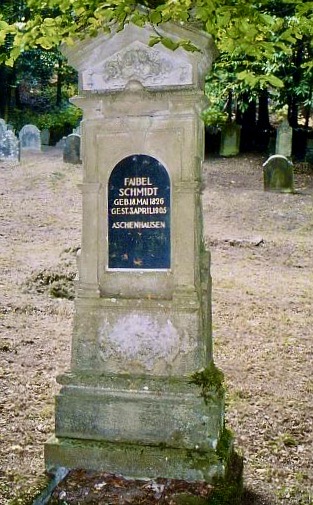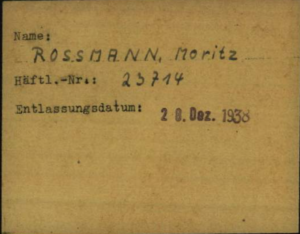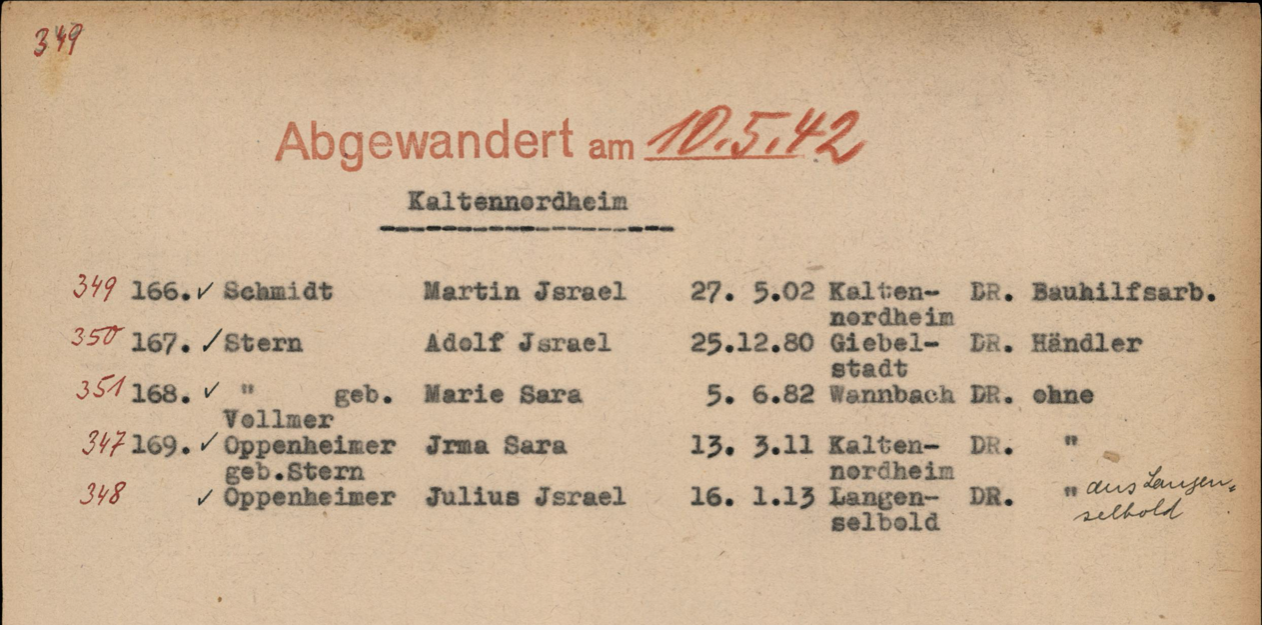What We Know:
Family name: Schmidt
Given name: Martin
Date/place of birth: 27 May 1902, Kaltennordheim
Date/place of death: Exact date of death unknown
Age: 40 years old at deportation
![]()
Martin Schmidt was born on 27 May 1902 in Kaltennordheim, the only child of Isaak Schmidt and his first wife, Ida Wollner.
 Martin was a member of a large family of Schmidts, whose earlier place of settlement was the village of Aschenhausen, 6 km southeast of Kaltennordheim. In 1718 Elias Levi, who added ‘Schmidt’ as a surname when Jews were required to do so, came to Aschenhausen as the Jewish Lehrer. He remained as Lehrer until 1852, and established “die Schmidt’schen Familien”. (1) Martin was the g-g-g-grandson of Elias Levi; his father, Isaak, was the sixth of eight living children of Faibel and Carolina (née Rosenbaum) Schmidt, both of whom were still alive when Martin was born.
Martin was a member of a large family of Schmidts, whose earlier place of settlement was the village of Aschenhausen, 6 km southeast of Kaltennordheim. In 1718 Elias Levi, who added ‘Schmidt’ as a surname when Jews were required to do so, came to Aschenhausen as the Jewish Lehrer. He remained as Lehrer until 1852, and established “die Schmidt’schen Familien”. (1) Martin was the g-g-g-grandson of Elias Levi; his father, Isaak, was the sixth of eight living children of Faibel and Carolina (née Rosenbaum) Schmidt, both of whom were still alive when Martin was born.
Martin’s uncle Jakob, b. 1861, had been among the first Jews to move from Aschenhausen to Kaltennordheim; in 1891, Jakob and Hannchen Schmidt’s first child, Max, was born in Kaltennordheim. In 1895, there were 48 Jews in a total population of 1,638. Isaak, 10 years younger than Jacob, was the second Schmidt to move to Kaltennordheim, probably after his marriage in 1901 to Ida Wollner. He established a cattle-trading business.
Some of Martin’s aunts and uncles remained in Aschenhausen; for example, Sophie Schmidt, b. 1869, remained after her marriage to Willy Katz who became Lehrer in 1898 and officiated until 1910. Others moved to larger urban centres such as Erfurt or Frankfurt am Main.
When Martin’s mother, Ida, died in 1903, his father married Ida’s sister, Mathilde Wollner, and Martin was brought up in the household of Isaak and Mathilde and their daughter, Toni, b. 1904.
Martin did not join his father’s cattle trading business but instead had a “Gemischtwaren” (General) shop in the town. There is no indication that Martin married. His stepsister, Toni, married Moritz Roßmann, b. 1901 in Woelfersheim in Hessen. They lived in Weissenheim a. Sand, about 242 km southwest of Kaltennordheim, where Moritz Roßmann owned a small grocery store in Lambsheimer Straße (today Dr.-Welte-Straße). Daughter Liselotte was born in 1931; Moritz became president of the Jewish community in 1932.
*****
When the Nazi Regime began in January 1933, most of the large Schmidt family lived in Germany. Isaak, Mathilde and Martin lived in Kaltennordheim. They remained in the town and in the 1938 Novemberpogrom, Martin was arrested and hauled off to the Buchenwald concentration camp. He was only released on 21 December 1938, possibly because he was unable to show that he had plans to emigrate from Germany.

The same may well have been the story of Moritz Roßmann; he was also placed in so-called Schutzhaft (protective custody) and hauled off to Dachau concentration and only released on 28 December 1938.

It is not known whether any family members tried to leave Germany. Tragedy struck on 22 October 1940 when the three Roßmanns—Moritz, Toni and Liselotte (called Lotte)—were taken away in a large black automobile by the Gauleiter of Lambsheim. They were allowed to take only a small suitcase with them.
The Roßmanns were held in the internment campt at Gurs and the transit camp at Drancy until 1942 but whether they were together in the camps is unclear. Moritz was the first to be deported; on 11 October 1942, he was sent to Auschwitz. Toni and Lotte remained in France for more than a year; on 7 December 1943, the two of them were sent to Auschwitz. Toni was 39 years of age, Lotte was 12.
*****
Forty-year old Martin was the first of the Schmidts in Germany to be deported. On 9 May 1942 he left Kaltennordheim and taken to Weimar and from there to Belzyce Ghetto. The deportation list identified his occupation as a “Bauhilfsarbeiter/construction worker” to promote the lie that he was being sent ‘east’ to work.


When his father and stepmother were deported to Theresienstadt in September 1942, a different lie was told, namely, that they were going to a retirement home.
Quellen:
Stefan Frühauf and Elke Schwerde, “Aschenhausen,” in Hans Nothnagel et. al, Juden in Südthüringen: geschützt und gejagt, (1999) Band 5, p. 68
Hans Nothnagel: ,,Jüdisches Leben in Kaltennordheim. Ein Resümee.” In: Hans Nothnagel (Hrsg.): Juden in Südthüringen, geschützt und gejagt. Band 5: Jüdische Gemeinden in der Vorderrhön. S. 90-122.
,,Die Synagoge Weisenheim am Sand,” alemannia-judaica.de